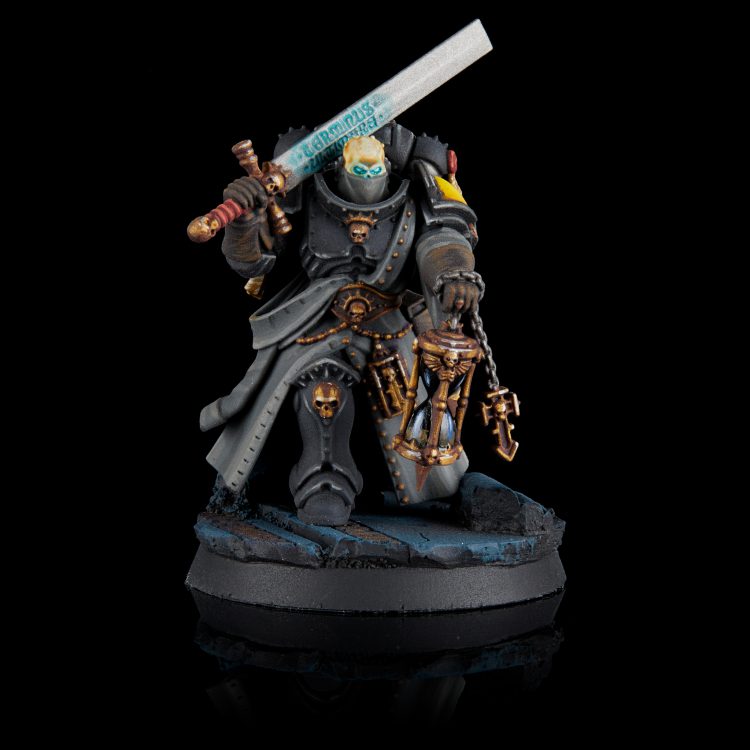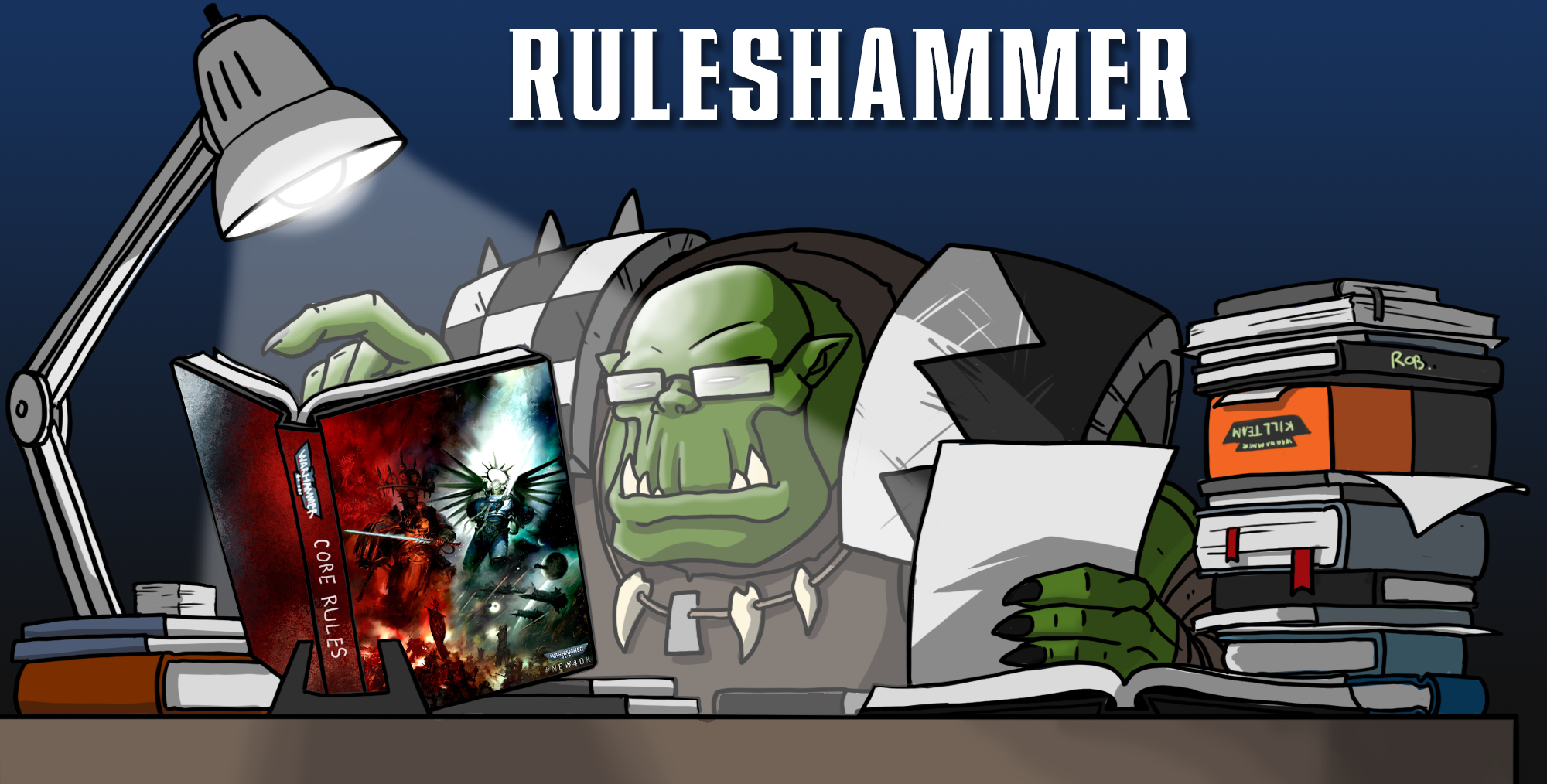Ruleshammer here again for another week, it’s still the holidays for me so here’s a few quick answers to help you out as you convince anyone nearby to play a festive game of Warhammer with you! Going forward, a few days after each new Q&A is released, I will be adding these questions and any feedback I get on them to the Ruleshammer Compendium. Hopefully this will make checking what I’ve covered and finding past answers easier!
Question 1 – “re-roll a hit roll of 1”, is this a single attack or all my attacks?
With the new wording on the auras of captains and lieutenants does the aura function as it did in 8th edition or has it changed to allow you to rerroll just one dice per model?
First lets look at the wording for some new Space Marine auras.
While a friendly <CHAPTER> CORE unit is within 6″ of this model, each time a model in that unit makes an attack, re-roll a hit roll of 1. [SM Codex 2020 Pg129]
Space Marines are not unique here, Games Workshop started to make efforts to alter the wording of these abilities some time before the end of 8th. I have highlighted the important par though, this ability is triggered each time a model makes an attack. If the model is making several attacks then it will trigger several times. So you can re-roll all the 1s the unit rolls to hit. I think these changes were made to better align them with how the rules instruct attacks to be resolved one at a time, fast rolling only when it doesn’t change the possible outcomes.

Question 2 – Ignore Modifiers vs Change Characteristic abilities
I took a Culexus Assassin vs Space Wolves. Culexus has a rule that says you treat the BS and WS as a 6+. Space Wolves have a stratagem that ignores any and all modifiers, Keen Senses. My opponent argued that the BS and WS change of the Culexus was a modifier and he could ignore it with his stratagem, but I said it was not a modifier. Are modifiers a general change to the BS or WS like the Culexus’ ability, or is it specifically the +1/-1 given to models after rerolls? Thanks!
I think you were correct, that “treat as having BS/WS 6+” is not a modifier as far as the rules are concerned. This probably needs another FAQ to be 100% certain but there are some related FAQs for modifiers that I think allow you to resolve this consistently. Essentially there are two types of “modifier”;
Many rules modify the characteristics of models and weapons. All modifiers to a characteristic are cumulative; you must apply division modifiers before applying multiplication modifiers, and before applying addition and then subtraction modifiers. Round any fractions up after applying all modifiers. If a rule instructs you to replace one characteristic with a specified value, change the relevant characteristic to the new value before applying any modifiers that apply from other rules (if any) to the new value. Regardless of the source, the Strength, Toughness, Attacks and Leadership characteristics of a model can never be modified below 1.
Arithmetic Modifiers (add, subtract, multiply and divide) and Replacement Modifiers, the ones that tell you to replace on characteristic with a specified value. Importantly Replacement Modifiers are to be done before arithmetic ones. Currently my position on “treat as” abilities is that are neither of those types and are therefore not modifiers. The Culexus ability uses “treat as”.
Etherium: When resolving an attack that targets this model, the attacking model is treated as having a Weapon Skill and Ballistic Skill characteristic of 6+.
I do have some FAQs reasoning for this, but the FAQs are not 100% in agreement about this interaction. This is what I mean about it needing it’s own FAQ because applying precedent like this is not a solid argument – 40k rules are not litigation. I’ve mentioned these examples before when talking about “treat as AP0” abilities.
Q: If the Dour Duty Stratagem is used on a unit that is within 6″ of a model with the Bastion Warlord Trait, will enemy attacks with an Armour Penetration characteristic of -2 that are made against that unit be treated as AP -1 or AP 0?
A:The attacks will be treated as AP 0. The Dour Duty Stratagem turns any attacks with AP -2 that are made against that unit into AP -1, at which point the Bastion Warlord Trait will cause them to be treated as AP 0. – [Faith & Fury FAQ]
And for clarity here’s the wording for the stratagem and for that Warlord Trait.
Dour Duty: Use this Stratagem in your opponent’s Shooting phase or your Charge phase, when an IRON WARRIORS unit from your army is chosen as the target for an attack. Until the end of that phase, when resolving an attack made with a ranged weapon against that unit, worsen the Armour Penetration characteristic of that weapon by 1 for that attack (e.g. AP -1 becomes AP 0).
Bastion: When resolving an attack made with a weapon that has an Armour Penetration characteristic of -1 against a friendly IRON WARRIORS unit that is within 6″ of this Warlord and receiving the benefit of cover, that weapon is treated as having an Armour Penetration characteristic of 0
This is why I don’t think “treated as” is a modifier; if it was it would be a Replacement modifier, as in “change AP-1 to AP0”. However as I pointed out the rules for those modifers say they happen before arithmetic ones. So this FAQ explaining to apply the arithmetic one first (worsening AP-2 to AP-1 by adding 1) and then basing the “treat as” ability on it’s new value indicates to me that they are an entirely separate thing.

Question 3 – Judiciar vs First Fight Effects
I’ve been playing Slaanesh and nearly every model has the “Quicksilver Swiftness” rule allowing the model to fight first in the fight phase even if they didn’t charge. I recently played a game where I faced the Judiciar for the first time. I ended up in the situation of charging a unit that brought me within 3 inches of him and my opponent triggered his “Tempormortis” rule meaning my model now fights last. We played it out with my models fighting after everything else but when I checked the rules later I found this statement in the “Rare Rules” section of the Core Rule book “If a unit is under the effects of both a rule that always lest it fight first in the Fight phase, and a rule that says it cannot be selected to fight until after all other units have done so it instead fights as if neither rule is affecting it.” The question I have is in the situation where a unit that has a fight first rule charges into, or in the case of a Judiciar within 3 inches of, a model with a rule that can apply a fight last rule how would this play out? Both the fight first rule for the model as well as the fight first for the charge are canceled so you play the fight as standard alternating activations or just the fight first granted by a model rule and the model that charged still goes first because it charged, or does the model that charged just end up fighting last?
Of all the facets of Fight Order I have covered, I can’t believe I’ve looked at the Judiciar as many times as I have and not talked about how it’s new wording interacts with Fight First. The short answer is that units affected by Judiciar – regardless of their own abilities or if they charged that turn – fight last. There’s a reason for this however; once again let’s look at wording for the Judiciar’s ability;
At the start of the Fight Phase, you can select one enemy unit within 3” of this model. That unit is not eligible to fight this phase until after all eligible units from your army have done so.
There are two issues here.
- The Judiciar (and a few other new abilities) muck with the fight phase using a different mechanic than old “fight last” effects. These new ones alter a unit’s Eligibility.
- The Rare Rule does not cover units affected by the Judiciar ability at all, which is somewhat confusing.
So why doesn’t the rare rule apply here? It’s because it doesn’t actually have the wording the rare rule is looking for.
…and a rule that says it cannot be selected to fight until after all other units…
is not
That unit is not eligible to fight this phase until after all eligible units…
The Fight First abilities require the unit be eligible to fight. If for instance an Slaanesh Daemon is affected by a Judiciar then it’s not eligible, just like all the other units that aren’t in combat that turn who aren’t eligible and can’t fight. The affected unit isn’t eligible and can’t fight, it can’t even be selected, until the Judiciar’s restriction is met.
This unit always fights first in the Fight phase, even if it didn’t charge. If the enemy has units that have charged, or that have a similar ability, then alternate choosing units to fight with, starting with the player whose turn is taking place.
nothing there says this unit is always eligible. Otherwise the abilities would allow all of them to be selected to fight in every turn, regardless of it they charged or if they have any enemy models within Engagement Range. Eligiblity is defined in the Fight Phase rules.
An eligible unit is one that is within Engagement Range of an enemy unit and/or made a charge move in the same turn. If neither player has any eligible units to fight with, the Fight phase ends.
It’s probably best to think of units affected by Judiciar as just “not being in combat” at all until you’ve resolved everything else (though obviously they’re still able to be the target of attacks).
Have any questions or feedback? Got a rules question you want answered? Drop us a note in the comments below, ask a question in our Ruleshammer form, or head over to r/ruleshammer to discuss.


